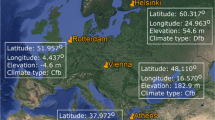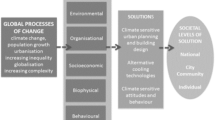Abstract
In the coming decades, global warming and increase in temperature, in different regions of the world, may change indoor and outdoor thermal comfort conditions and human health. The aim of this research was to study the effects of global warming on thermal comfort conditions in indoor ambiences in Iran. To study the increase in temperature, model for assessment of greenhouse-gas induced climate change scenario generator compound model has been used together with four scenarios and to estimate thermal comfort conditions, adaptive model of the American Society of Heating, Refrigerating and Air-conditioning Engineers has been used. In this study, Iran was divided into 30 zones, outdoor conditions were obtained using meteorological data of 80 climatological stations and changes in neutral comfort conditions in 2025, 2050, 2075 and 2100 were predicted. In accordance with each scenario, findings from this study showed that temperature in the 30 zones will increase by 2100 to between 3.4 °C and 5.6 °C. In the coming decades and in the 30 studied zones, neutral comfort temperature will increase and be higher and more intense in the central and desert zones of Iran. The low increase in this temperature will be connected to the coastal areas of the Caspian and Oman Sea in southeast Iran. This increase in temperature will be followed by a change in thermal comfort and indoor energy consumption from 8.6 % to 13.1 % in air conditioning systems. As a result, passive methods as thermal inertia are proposed as a possible solution.
Similar content being viewed by others
References
Abbaspour, M.; Jafari, M. J.; Mansouri, N.; Moattar, F.; Nouri, N.; Allahyari, M., (2008). Thermal comfort evaluation in Tehran metro using Relative Warmth Index. Int. J. Environ. Sci. Tech., 5(3), 297–304 (8 pages).
ASHRAE Standard 55. (2004). Thermal Environmental Conditions for Human Occupancy (ANSI Approved).
Berry, H. L.; Bowen, K.; Kjellstrom, T., (2009). Climate change and mental health: A causal pathways framework. Int. J. Public. Health, 55(2) 123–132 (10 pages).
Etemad-Shahidi, A.; Zoghi, M. J.; Saeedi, M., (2010). An alternative data driven approach for prediction of thermal discharge initial dilution using tee diffusers. Int. J. Environ. Sci. Tech., 7(1), 29–36 (8 pages).
Foruzanmehr, A.; Nicol, F., (2008). Towards new approaches for integrating vernacular passive-cooling system into modern building in warm-dry climates of Iran. Proceedings of conference: Air Conditioning and the low Carbon Cooling Challenge. Cumberland Lodge, Windsor, UK, 27–29 July. London.
Fransson, N.; Yästfjäll, D.; Skoog, J., (2007). In search of the comfortable indoor environment: A comparison of the utility of objective and subjective indicators of indoor comfort. Build. Environ., 42(5), 1886–1890 (5 pages).
Gulyas, A.; Unger, J.; Matzarakis, A., (2006). Assessment of the microclimatic and human comfort conditions in acomplex urban environment: Modelling and measurements. Build. Environ., 41(12), 1713–1722 (10 pages).
Humphreys, M. A.; Nicol, J. F., (2000). Outdoor temperature and indoor thermal comfort: Raising the precision of the relationship for the 1998 ASHRAE database of field studies. ASHRAE Transact., 206(2), 485–492 (8 pages).
Humphreys, M. A., (1978). Outdoor temperature and comfort indoors. Build. Res. Pract., 6(2), 92–105 (14 pages).
ISO 10551. (1995). Ergonomics of the thermal environment-Assessment of the influence of the thermal environment using subjective judgement scales.
Kalkstein, L. S.; Greene, J. S., (1997). An evaluation of climate/ mortality relationships in large U.S. cities and the possible impacts of a climate change. Environ. Health Perspect., 105(1), 84–93 (10 pages).
Kont, A.; Jaagus, J.; Aunap, R., (2003). Climate change scenario and the effect of sea-level rise for Estonia. Glob. Plan. Chang., 36(1–2), 1–15 (15 pages).
Langford, I. H.; Bentham, G., (1995). The potential effects of climate change on winter mortality in England and Wales. Int. J. Bioclimat., 38(3), 141–147 (7 pages).
Lin, Z.; Deng, S., (2006). A study on the thermal comfort in sleeping environments in the subtropics-Developing a thermal comfort model for sleeping environments. Build. Environ., 43(1), 70–81 (12 pages).
Martens, W. J., (1998). Climate change, thermal stress, and mortality change. Soc. Sci. Med., 46(3), 331–344 (14 pages).
Matzarakis, A.; Mayer, H., (1997). Heat stress in Greece. Int J. Biometeorol., 41(1), 34–39 (6 pages).
McCartney, K. J.; Nicol, J. F., (2002). Developing an adaptive control algorithm for Europe. Energy Build., 34(6), 623–635 (12 pages).
Miller, H., (2008). The attributes of thermal comfort. (Solution Essay) Ergonomic criteria for the design of “breathable” work chairs. http://www.hermanmiller.com/MarketFacingTech/hmc/solution_essays/assets/se_Attributes_of_Thermal_Comfort.pdf.
Nicol, J. F., (2004). Adaptive thermal comfort standards in the hot-humid tropics. Energy Build., 36(7), 628–637 (10 pages).
Nicol, J. F.; Humphreys, M., (2007). Maximum temperatures in European office buildings to avoid heat discomfort. Sol. Energy, 81(3), 295–304 (10 pages).
Nicol, J. F.; Humphreys, M. A., (2002). Adaptive thermal comfort and sustainable thermal standards for buildings. Energ. Buildings., 34(4), 563–572 (10 pages).
Nicol, J. F.; Humphreys, M. A., (1973). hermal comfort as part of a self regulating system, in: Proceedings of the CIB Symposium on thermal comfort. Building Research Establishment, Watford, UK.
Olalekan, F.; Osanyintola, O. F.; Simonson, C. J., (2006). Moisture buffering capacity on hygroscopic building materials: Experimental facilities and energy impact. Energ. Buildings., 38(10), 1270–1282 (13 pages).
Orosa, J. A., (2009). Research on the origins of thermal comfort. Eur. J. Sci. Res., 34(4), 561–567 (7 pages).
Orosa, J. A.; Oliveira, A., (2009). Energy saving with passive climate control methods in Spanish office buildings. Energ. Buildings., 41(8), 823–828 (6 pages).
Pandey, M., (2005). Global warming and climate change. Publisher Dominant Publishers and Distributors.
Panjeshahi, M. H.; Ataei, A., (2008). Application of an environmentally optimum cooling water system design in water and energy conservation. Int. J. Environ. Sci. Tech., 5(2), 251–262 (12 pages).
Piotrowicz, K., (2009). The occurrence of unfavorable thermal conditions on human health in central europe and potential climate change impacts: An example from cracow, Poland. Environ. Manage., 44(4), 766–775 (10 pages).
Praveena, S. M.; Aris, A. Z., (2010). Groundwater resources assessment using numerical model: A case study in low-lying coastal area. Int. J. Environ. Sci. Tech., 7(1), 135–146 (12 pages).
Prek, M., (2006). Thermodynamical analysis of human thermal comfort. Energy, 31(5), 732–743 (12 pages).
Radhi, H., (2009). Evaluating the potential impact of global warming on the UAE residential buildings — A contribution to reduce the CO2 emissions., Build. Environ. 44(12), 2451–2462 (12 pages).
Roshan, G. R.; Rousta, I.; Ramesh, M., (2009). Studying the effects of urban sprawl of metropolis on tourism-climate index oscillation: A case study of Tehran city. J. Geograph. Region. Plan., 2(12), 310–321 (12 pages).
Sakoi, T.; Tsuzuki, K.; Kato, S. H.; Ooka, R.; Song, D.; Zhu, S. H., (2007). Thermal comfort, skin temperature distribution and sensible heat loss distribution in the sitting posture in various asymmetric radiant fields., Build. Environ., 42(12), 3984–3999 (15 pages).
Spagnolo, J.; Dear, R., (2003). A field study of thermal comfort in outdoor and semi-outdoor environments in subtropical Sydney Australia. Build. Environ., 138(5), 721–738 (18 pages).
Tian, Z.; Love, J., (2008). A field study of occupant thermal comfort and thermal environments with radiant slab cooling. Build. Environ., 43(10), 1658–1670 (12 pages).
Willem, P. N.; Christopher, J., (2009). Implications of fossil fuel constraints on economic growth and global warming Energ. Policy, 37(1), 166–180 (15 pages).
Zaman, A. U., (2010). Comparative study of municipal solid waste treatment technologies using life cycle assessment method. Int. J. Environ. Sci. Tech., 7(2), 225–234 (10 pages).
Zeiler, W.; Boxem, G., (2009). Effects on thermal activated building systems in schools on thermal comfort in winter. Build. Environ., 44 (11), 2308–2317 (10 pages).
Author information
Authors and Affiliations
Corresponding author
Rights and permissions
About this article
Cite this article
Roshan, G.R., Ranjbar, F. & Orosa, J.A. Simulation of global warming effect on outdoor thermal comfort conditions. Int. J. Environ. Sci. Technol. 7, 571–580 (2010). https://doi.org/10.1007/BF03326166
Received:
Revised:
Accepted:
Published:
Issue Date:
DOI: https://doi.org/10.1007/BF03326166




